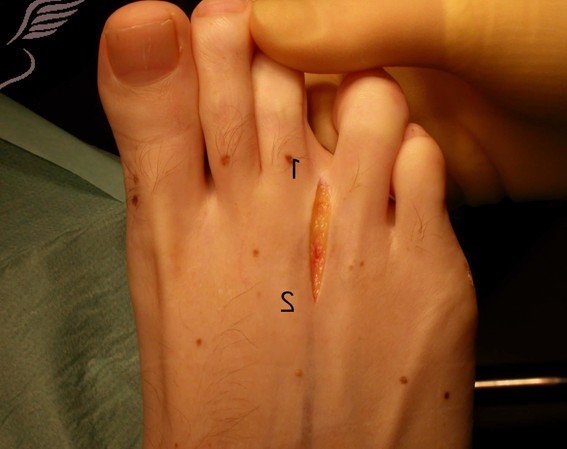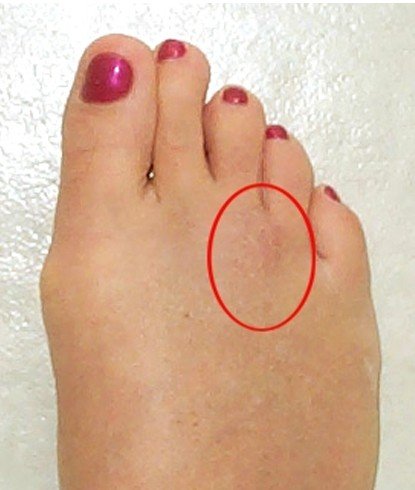Morton’s Neuroma
Last reviewed by Dr. Raj MD on January 12th, 2022.
What is Morton’s neuroma?
This is a medical condition that affects the space between your fourth and third toes which is considered the ball of your foot. It is considered a benign neuroma which is a tumor or growth of nerve tissue. Although it is called Morton’s neuroma it was first correctly described by a man named Durlacher, who was a chiropodist, who is a physician who specializes in the diagnosis and treatment of foot disorders. Although neuroma means a tumor this is not exactly a tumor but a fibrous tissue formation around the nerve tissue. Because it can be caused by too tight of a shoe women seem to be affected more often than men because of the high heels that many of them wear on a daily basis.
Morton’s Neuroma Symptoms
Each person who has Morton’s neuroma may have different degree of symptoms but the one thing that most everyone has is pain when bearing weight on the foot. The type of pain people can experience varies. Some say it feels like you are standing on a fold in your sock or on a pebble in your shoe while others have shooting pain that affects the contiguous halves of the two toes. Some even say it can feel like walking on razor blades.
Other general symptoms a person might experience can include:
- A burning feeling
- Numbness
- Paresthesia which is a sensation of prickling, burning, tickling, or pricking in their foot with no apparent physical long-term effect. It is often referred to as a pins and needle feeling.
Having Morton’s neuroma does not cause any outward signs like having a limp although it may be painful to walk or bear weight on the foot.
Causes of Morton’s Neuroma
A person can get Morton’s Neuroma when your lateral plantar nerve and your medial plantar nerve mesh together and result in an enlarged nerve that can cause pain and numbness within your foot area. Because these two combined nerves are larger than most of the other nerves that lead to your toe area any pressure that you place on this enlarged nerve will usually cause pain.
- Lateral plantar nerve – this is two nerves together that supply sensation to the skin and muscles of your toes and foot.
- Medial plantar nerve – this is the nerve that runs through the inner arch of each of your feet and allow movement and provide sensations of certain muscles and joints
Unfortunately what exactly causes this to happen is not known. Some of the risks factors that could contribute to Morton’s neuroma developing are:
- Having flat feet. This is because when a person has flat feet it can cause both of these nerves to be pulled towards the middle of the foot. When this happens it is highly possible that a person will develop Morton’s neuroma.
- People who wear confining shoes, which means shoes that are too tight, too narrow, or have too high of a heel, frequently may also experience Morton’s neuroma.
- Having an injury to one of the nerves that lead to the toes.
- Participating in certain sports like running or jogging that can subject your feel to repetitive trauma or sports that require you to wear tight shoes like for rock climbing or snow skiing and can put pressure on the toes.
- Having a foot deformity like hammertoes, bunions, or high arches
Diagnosis
The only way to be properly diagnosed as to whether you have Morton’s neuroma or not is to see a licensed podiatrist, who is also referred to as a podiatric physician and is devoted to the study and medical treatment of disorders of not only the foot but also the ankle and lower extremities. After listening to your symptoms the podiatrist will do a physical exam where they will press on your foot to see if there is a tender spot or mass. They may also be able to feel a “clicking” between the bones of the foot.
A podiatrist will usually use a series of imaging tests to make an accurate diagnosis which can include:
X-rays
This will be used to rule out any other causes that could be giving you pain in your foot like a stress fracture
Ultrasound
This is the type of technology that uses sound waves to create real-time images of the internal structure of your food. It is a good imaging test to use to reveal any soft tissue abnormalities
MRI (magnetic resonance imaging)
This is the imaging test that uses a strong magnetic field and radio waves to help visual the soft tissues in your foot.
The podiatrist will most likely use the x-ray and ultrasound imaging tests as having a MRI imaging test is quite expensive.
Treatment
What treatment will be used depends on how severe the symptoms are. Because it appears that one of the causes of possibly developing Morton’s neuroma is wearing confining shoes or ones with high heels it is best that you wear shoes with a lower heel so you are not putting all that weight on the front of your foot and ones that are a little wider at the toes. Some of the ways that a podiatrist will try to treat your Morton’s neuroma can include:
- Padding the affected area or having you wear arch supports which the podiatrist can have an individually designed custom-made shoe insert that will fit the contours of your foot or they may have you use ones that you can purchase over-the-counter.
- Taping the foot
- Given alcohol or steroid injections to harden the nerve to help reduce the swelling
Any of these treatments can help to reduce the size of the swollen nerve along with alleviating pain. If none of these treatments seem to be alleviating the problem you may have to have surgery. It is important to have this treated so the nerves can return to their normal state.
Some of the home treatments that you can try can include:
- Taking over-the-counter non-steroidal anti-inflammatory medications like naproxen (Aleve) or ibuprofen (Motrin IB or Advil) to help with the pain and reduce swelling.
- Massage your feet with ice by rolling a cup of frozen water over the painful site to help reduce the pain or apply a cold pack to the area for ten to fifteen minutes three to four times a day.
- Take a break from activities like dancing, aerobic exercise, or jogging that can subject your feet to repetitive motions.
- Massage your foot to help relax the muscles surrounding the nerve.
Morton’s Neuroma Surgery
Before surgery is done other treatments will be tried but usually surgery is the only way to eliminate the swollen nerve. Two of the different surgeries that can be done include:
Decompression surgery
It is possible at times for the surgeon to be able to relieve the pressure on the nerve by cutting the nearby structures like the ligament in the front of the foot that binds together some of the bones.
Removal of the nerve
If none of the treatments or decompression surgery does not give you pain relieve it may be necessary to surgically remove the growth, any other affected tissue, and nerves. Even though this surgery is usually successful having it done can result in having permanent numbness in the toes that were affected. This type of surgery is usually used as a last result because of the possible permanent numbness.
Morton’s Neuroma Pictures
Photos, Images and Pictures of Morton’s Neuroma…

